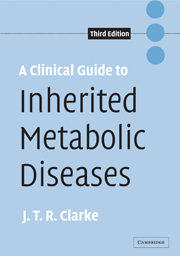Book contents
- Frontmatter
- Contents
- Reviews of first edition
- Reviews of second edition
- List of tables
- List of figures
- Preface
- 1 General principles
- 2 Neurologic syndrome
- 3 Metabolic acidosis
- 4 Hepatic syndrome
- 5 Cardiac syndromes
- 6 Storage syndrome and dysmorphism
- 7 Acute metabolic illness in the newborn
- 8 Newborn screening
- 9 Laboratory investigation
- 10 Treatment
- Index
- References
10 - Treatment
Published online by Cambridge University Press: 10 September 2009
- Frontmatter
- Contents
- Reviews of first edition
- Reviews of second edition
- List of tables
- List of figures
- Preface
- 1 General principles
- 2 Neurologic syndrome
- 3 Metabolic acidosis
- 4 Hepatic syndrome
- 5 Cardiac syndromes
- 6 Storage syndrome and dysmorphism
- 7 Acute metabolic illness in the newborn
- 8 Newborn screening
- 9 Laboratory investigation
- 10 Treatment
- Index
- References
Summary
The purpose of this chapter is to present some general principles of the management of inherited metabolic diseases using specific examples to illustrate various points. It is not meant to be a detailed guide to the specific treatment of any particular disease. Instead, it is intended to provide a conceptual scaffold to aid in understanding the strategy behind the management of various inborn errors of metabolism, particularly strategies involving environmental manipulation.
A logical approach to treatment would be to determine how various point defects in metabolism cause disease, and to reverse or neutralize them, either by dietary, pharmacologic, or some other form of metabolic manipulation. However, in many cases, our understanding of how a particular point defect in metabolism produces disease is still incomplete. Often the abnormality is metabolically or physically inaccessible to environmental manipulation. In the discussion to follow, examples are provided of how rational approaches to treatment grew out of an understanding of the primary and secondary consequences of inborn errors of metabolism. The emphasis is on instances in which treatment is at least partially successful.
Control of accumulation of substrate
When disease is caused by accumulation of the substrate of a reaction that is impaired as a result of deficiency of an enzyme or transport protein, a reasonable approach to treatment would be to try to control levels of the toxic metabolite, either by decreasing its accumulation or accelerating its removal by alternative reactions.
- Type
- Chapter
- Information
- A Clinical Guide to Inherited Metabolic Diseases , pp. 297 - 323Publisher: Cambridge University PressPrint publication year: 2005



